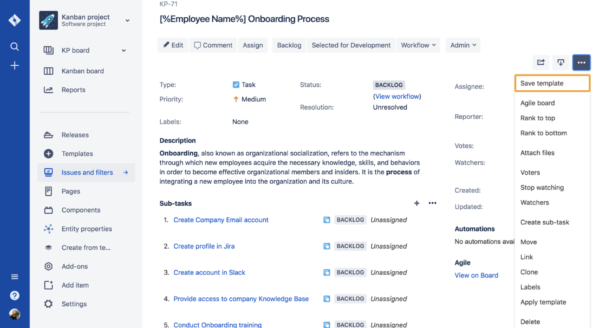How to optimize remote onboarding in the enterprise
Learn how Data Center products can help self-managed environments optimize their remote onboarding processes at enterprise scale.
The past year has brought a number of breaking changes to the way we work, and while we’re lucky enough to begin seeing the return of some Atlassians to office spaces in Australia, there’s no doubt that 2020 will have a lasting impact on how we think about work environments.
One of the more difficult aspects of remote work that’s emerged during this time is the absence of in-person interaction. While this is a challenge facing everyone, one group is particularly impacted: new hires. And this challenge has become a bigger burden for enterprise organizations that are bringing in new people at higher volumes than that of a small to medium business or startup. When it comes to large enterprise organizations, it’s far easier for a new hire to get lost in the shuffle (and end up feeling lost themselves). Research by Glassdoor found that organizations with a strong onboarding process improve new hire retention by 82% and productivity by over 70%, and the need for strong onboarding is only compounded when the opportunity to meet your new team face-to-face is no longer available.
How do you begin to optimize these processes at scale in a remote world? How can you ensure an exciting and insightful entry for all new hires into your organization – across function, business unit, geography and more? And most importantly, how do you make this process repeatable?
There is no one solution to achieve this, but there are a number of practices (and products to support them) that can help make onboarding as impactful as it can be for fast-growing, global organizations in a remote world. It’s something that Atlassian takes great pride in, as we’ve exercised these practices to the tune of nearly 1,000 remote new hires across the past year. So let’s take a look at what you can do to ensure your new hires have the resources and guidance required to succeed at their new roles out of the gate.
It takes a village
For starters, it’s important to remember that enterprise onboarding is cross-functional by nature. All teams share the objective of bringing on new talent, and there are various onboarding milestones that venture into territory outside of the hiring team’s immediate purview, from benefit enrollment to provisioning new user access to the right products. If collaboration breaks down between these departments, new hires are left spinning their wheels without the right tools or information to settle into their role. The key to a successful (and consistent) onboarding experience is the ability to track and manage your new hire workflows.
For the growing enterprise, the best way to ensure seamless collaboration is by organizing a repeatable process like new employee onboarding, however, managing this manually can be quite time-consuming. Every time, HR needs to create a big number of identical actions and assign them to out to the appropriate people. If this sounds antiquated, it’s because it is.
One easy solution is streamlining the process using Jira, and specifically, leveraging the Jira subtasks template. With Jira, every single step of the onboarding process may be a subtask linked to a single Jira issue created per new employee; and with the Easy Templates for Jira issues add-on, it’s a breeze to create a Jira Template that contains dedicated subtasks. Using Jira as a means to manage and track your onboarding efforts enables you to establish a uniform process across the entire enterprise. Jira makes it easier to streamline the cross-functional collaboration required at scale, and ensure that no new hire is left stranded without the resources and answers they need.

Another way to take a more hands-on approach to guiding your new hires is by making it easier to get answers. In today’s enterprise landscape, admins or IT support can’t get caught up in ongoing, one-off requests. In a small to medium-sized business, it’s feasible to handle these requests manually, but when a consistently high number of employees expect immediate service and open access to internal systems, it can become overwhelming quickly. That’s why Jira Service Management’s HRSM (Human Resources Service Management) solution offers a consumer quality self-service portal, automating HR service delivery for competitive onboarding experiences, and simplifying access to internal tools.
But what takes this solution to the next level for enterprises is how Jira Service Management works with Confluence as a knowledge base for a two-pronged attack at getting ahead of end-user questions. The larger an organization, the more knowledge articles there are to sift through and find the answers you need. With Confluence, once you’ve created knowledge base articles, new hires can automatically see recommended articles as they type their requests into Jira Service Management, like magic. All you have to do is enable auto-search for request forms from your settings, and you’ll be closing up that to-do list in no time. For step-by-step instructions on how to enable auto-search, we have documentation you can reference.
Setting your new teammates up for success
As we mentioned earlier, one of the make-or-break moments in the onboarding process is having immediate access to the tools your team needs to get up to speed. When end-users are unhappy, you hear about it – especially when a team is trying to bring new members up to speed as quickly as possible – and this problem is only compounded at scale. Any friction that prevents them from gaining access to the tools they need to do their job will result in negative user experiences, plus more work on your plate.
Enterprise organizations need automation in order to mitigate the overflow of new hire provisioning, which is exactly why our Data Center products includes features such as JIT (just-in-time) provisioning. With JIT provisioning, you can avoid access issues for end-users and get new members of the teams your Atlassian products support up to speed faster. When users are given the tools they need, their ability to interact, collaborate, and gel with the team improves.
But it’s not only limited to JIT provisioning; our self-managed enterprise offering provides a number of user management benefits, such as single sign-on support for the leading authentication protocols, SAML and OpenID Connect, and more to come – that will help make managing your onboarding process at scale much easier.
Fostering culture with collaboration
Last but not least, one of the biggest hurdles of onboarding in today’s remote workplace is ensuring that new hires experience the culture of their team (and that of the broader organization) firsthand. As we mentioned earlier, one of the biggest difficulties in today’s hiring practices is making a new employee feel welcomed and included amongst tens of thousands of others (who likely have experienced face-to-face interaction with their teammates). There’s not an easy solution for this, but with the broad functionality of Confluence, there are ways to encourage team cohesion through collaboration.
One practice that we deploy here at Atlassian – and I guess you could call it a tradition – is the intro blog, which every new hire is encouraged to write following their first week on the team. Intro blogs present an opportunity to share who a new team member is – their interests, passions, and relationships, both on and off the clock. With inline comments, new teammates can call out areas of similar interest, ask deeper questions, share anecdotes, and ultimately show any new hire that they have a supporting community.
Confluence can also be used to run different kinds of plays that encourage team building. From icebreaker activities to building empathy and identifying the right level of support while adjusting to remote work, Atlassian’s Team Playbook provides myriad workshop resources that pair with Atlassian products to help improve team cohesion.
The bottom line is that you need a space for new hires to feel welcome when they’re joining such a large and established organization, comfortable with sharing aspects of their personal life to create bonds beyond working meetings, and engrained with the company culture and values.
What does this mean for the future of onboarding?
Remote work is here to stay – in some way, shape, or form – and this means that remote onboarding is also a process we’re going to need to evolve with. There will never be a replacement for human-to-human interaction, but we can optimize the options available in this new landscape.
If you’re interested in learning more about Atlassian Data Center, our self-managed enterprise offering, and how it can help with things like remote onboarding (and much more), check out our ultimate guide to Data Center.
